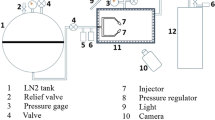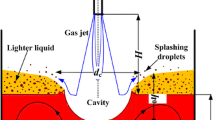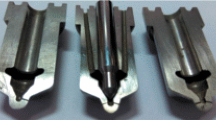Summary
The structure of the free oxygen jets issuing from multiple jet oxygen lances has been investigated on the model scale and has been found to be identical with the structure predicted from the available correlations on supersonic jet characteristics, assuming that the jets do not interact. For jet inclination angles of 10° or greater, the jet flow fields are entirely separate and the individual jets do not interact. For jets inclined at 5° the flow fields were found to intersect before bath level is reached.
The results of plant experience with one- and three-hole lances in the Cleveland BOF and one- and two-hole lances in the Aliquippa BOF are discussed in terms of these jet characteristics. It has been found that the optimum lance heights for different lance types in a given furnace all give the same impact area (or jet cross-section area) at the bath surface level. At these optimum lance heights the relative jet penetrating power achieved with multiple hole lances is equal to, or greater than, that of the single-hole lances. The case of deeper penetration is obtained by using higher gas exit velocity (or higher oxygen driving pressures) for the multiple-hole lance.
Similar content being viewed by others
References
E. J. Sobey: Journal of Metals, 1965, vol. 17, no. 4, pp. 424–425.
S. Morita, M. Nishiwaki, T. Yamaguchi, I. Tanaka, and M. Ando: Tetsu to Hagane, 1964, vol. 50, pp. 1733–1735.
H. W. Liepman and A. Roshko: Elements of Gas Dynamics, chapter 6, John Wiley, New York, 1957.
A. H. Shapiro: The Dynamics and Thermodynamics of Compressible Fluid Flow, Ronald Press, New York, 1953.
S. Pai: Fluid Dynamics of Jets, Van Nostrand, New York, 1954.
Equations, Tables, and Charts for Compressible Flow, NACA Report No. 1135, US Government Printing Office, Washington, D. C., 1953.
A. R. Anderson and F. R. Johns: Jet Propulsion, 1955, vol. 25, pp. 13–15, 25.
R. W. Ladenburg, B. Lewis, R. N. Pease, and H. S. Taylor: Physical Measurements in Gas Dynamics and Combustion, Princeton University Press, Princeton, N. J., 1954.
H. Krainer, K. Borowski, and J. Maatsch: Krupp Technical Review, 1965, vol. 23, pp. 53–56.
Author information
Authors and Affiliations
Rights and permissions
About this article
Cite this article
Smith, G.C. Multiple jet oxygen lances — Theoretical analysis and correlation with practice. JOM 18, 846–851 (1966). https://doi.org/10.1007/BF03378475
Published:
Issue Date:
DOI: https://doi.org/10.1007/BF03378475




